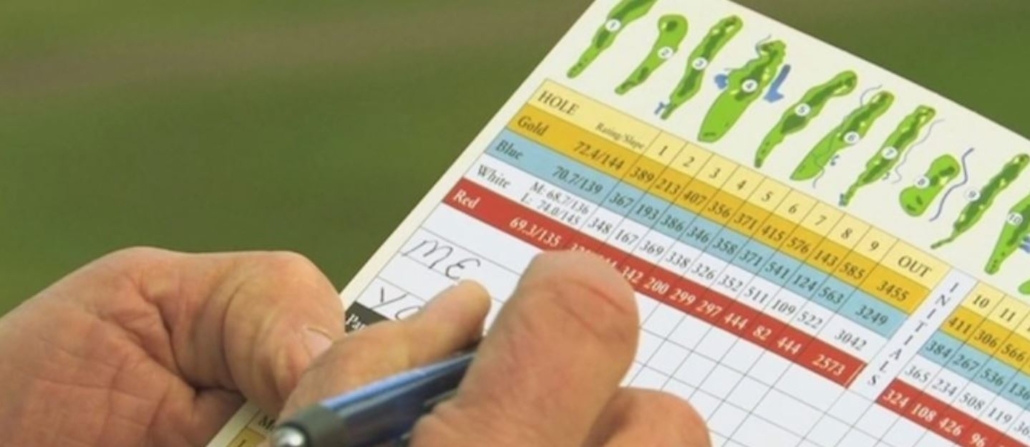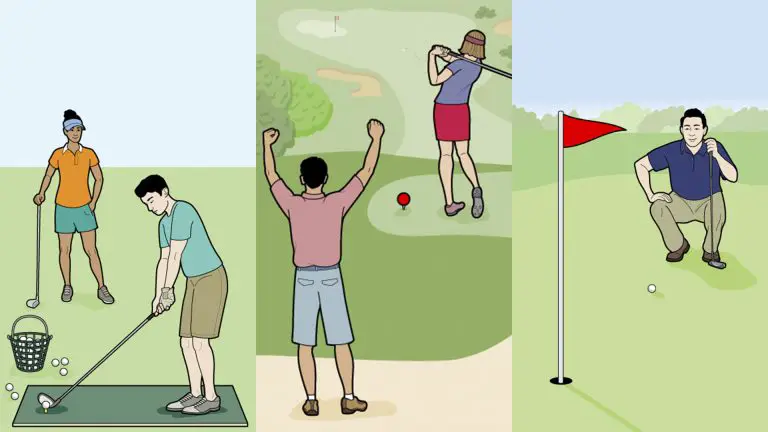What Is My Golf Handicap

Golf is a game that captivates and challenges players of all skill levels. Whether you’re a beginner or a seasoned golfer, you may have heard the term “golf handicap” being thrown around. But what exactly is a golf handicap, and how does it apply to your game? In this article, we will unravel the mystery behind golf handicaps and explore how they can enhance your golfing experience.
A golf handicap is a numerical measure of a player’s skill level and ability on the golf course. It serves as a leveling system that allows golfers of different skill levels to compete against each other on an equal playing field. By providing a standardized way to compare players, handicaps enable fair competition and create an inclusive environment for golfers of all abilities.
In this comprehensive guide, we will delve into the world of golf handicaps, starting with the basics of what a handicap is and why it is important. We will then explore how handicaps are determined, calculated, and used in golf competitions. Additionally, we will provide practical tips on establishing and improving your own handicap.
Whether you’re interested in understanding how handicaps work, determining your own handicap, or using it to enhance your golfing journey, this article has you covered. So, let’s dive in and unlock the secrets of your golf handicap.

Determining and Calculating Your Golf Handicap
What Is a Golf Handicap and Why Is It Important?
A golf handicap is a numerical value that represents a player’s ability in relation to the difficulty of a golf course. It is used to level the playing field when golfers of different skill levels compete against each other. By adjusting the number of strokes a player receives, a handicap enables fair competition and enhances the enjoyment of the game.
Your golf handicap serves as a benchmark for measuring your progress and skill improvement over time. It allows you to track your performance, set realistic goals, and challenge yourself to continually improve your game.
The Purpose of a Golf Handicap System
The golf handicap system is designed to provide a standardized method for calculating handicaps and promoting fair competition. It takes into account the difficulty of the golf course and adjusts the number of strokes a player receives based on their handicap. This ensures that golfers of different abilities can compete on an equitable basis, regardless of their skill level.
The handicap system allows players to compare their performance against others, regardless of skill level, by providing a common metric. It also enables players to participate in various types of golf competitions, such as net score events, where the handicap is used to determine the winner.
How Is a Golf Handicap Calculated?
Calculating a golf handicap involves several key factors, including the course rating, slope rating, handicap differential, handicap index, and course handicap. Let’s explore each of these components in more detail:
Course Rating and Slope Rating
The course rating represents the difficulty of a golf course for a scratch golfer, while the slope rating reflects the relative difficulty of the course for an average golfer compared to a scratch golfer. These ratings are determined by golf associations or governing bodies and are used as a basis for calculating handicaps.
Handicap Differential
The handicap differential is a measure of a player’s score relative to the difficulty of the course. It is calculated by subtracting the course rating from the player’s adjusted gross score and multiplying the result by the standard slope rating. The handicap differential is used to establish a player’s handicap index.
Handicap Index
The handicap index is a numerical representation of a player’s potential ability, calculated based on the average of the best handicap differentials from a specified number of rounds. The handicap index represents the player’s playing potential and is used to determine the course handicap for different golf courses.
Course Handicap
The course handicap is the number of strokes a player receives for a specific golf course. It is derived from the player’s handicap index and the slope rating of the course being played. The course handicap allows players of different skill levels to compete fairly by adjusting their scores based on the difficulty of the course.
Establishing Your Golf Handicap
Registering with a Golf Handicap Provider
To establish your golf handicap, you will need to register with a recognized golf handicap provider. Golf associations and organizations offer handicap services, allowing you to enter your scores, calculate your handicap index, and access your handicap information.
Registering with a handicap provider ensures that your handicap is official and recognized for competitive play. It also provides access to handicap revision updates and ensures compliance with the rules and regulations of the handicap system.
Submitting Scorecards and Establishing a Handicap Index
To establish your handicap, you will need to submit scorecards from a minimum number of rounds played. The exact requirements may vary depending on the handicap provider or governing body, but typically a minimum of five to twenty scores is required.
The submitted scores will be used to calculate your handicap differentials and establish your handicap index. The more scores you submit, the more accurate your handicap index will be, as it is based on a representative sample of your playing ability.
How Many Scores Are Needed to Establish a Handicap?
The number of scores required to establish a handicap can vary depending on the handicap provider or governing body. Generally, a minimum of five to twenty scores is needed to establish a handicap index. The exact requirements will be specified by your chosen handicap provider.
It’s important to note that scores used for handicap calculation should be representative of your current playing ability. It is recommended to submit scores from different courses and a variety of playing conditions to ensure a well-rounded representation of your skills.
Understanding Handicap Index and Course Handicap
Handicap Index: What It Represents
The handicap index is a numerical value that represents your potential ability as a golfer. It is calculated based on the average of the best handicap differentials from the scores you have submitted. The handicap index serves as a standardized measure of your playing potential and enables fair competition with golfers of different skill levels.
The handicap index is a portable value that can be used across different golf courses and allows for equitable comparisons between players. It is an essential tool for organizing golf competitions and determining the course handicap for individual players.
Converting Handicap Index to Course Handicap
The course handicap is the number of strokes a player receives for a specific golf course. It is derived from the player’s handicap index and the slope rating of the course being played. Converting the handicap index to a course handicap allows players to compete on an equitable basis, regardless of the difficulty of the course.
Course handicap tables or online calculators are commonly used to determine the course handicap based on the player’s handicap index and the slope rating of the course. The course handicap provides an adjustment that reflects the playing difficulty of the course and allows players to compete on a level playing field.
Adjusting Course Handicap for Playing Conditions
In certain situations, course handicaps may need to be adjusted to account for specific playing conditions. The United States Golf Association (USGA) provides guidelines for adjusting course handicaps based on factors such as the playing difficulty, weather conditions, or course setup for a particular event.
Course handicap adjustments ensure that the playing field remains fair and equitable, even in exceptional circumstances. It allows for the flexibility to adapt the course handicap to match the specific conditions players may encounter during a round.
Using Your Handicap in Golf
The Purpose of Using a Handicap in Competition
The primary purpose of using a handicap in golf competitions is to level the playing field for players of different abilities. By adjusting the number of strokes a player receives based on their handicap, the competition becomes fair and inclusive, allowing golfers to compete on an equal footing.
Using handicaps in competition allows players to measure their performance against others, regardless of skill level. It provides an opportunity to showcase skills, track progress, and engage in healthy competition with fellow golfers.
Playing in Net Score Competitions
Net score competitions are a popular format in golf where players compete based on their net scores rather than their gross scores. Net scores are calculated by subtracting the player’s course handicap from their gross score, resulting in a score that reflects their performance relative to the difficulty of the course.
Net score competitions allow golfers of all abilities to compete against each other on an equitable basis. It provides an opportunity for players with higher handicaps to be competitive and potentially win against players with lower handicaps, as the handicap adjustment levels the playing field.
Calculating Net Score Using Your Handicap
To calculate your net score, you subtract your course handicap from your gross score. The net score reflects your performance adjusted for the difficulty of the course. For example, if your gross score is 85 and your course handicap is 10, your net score would be 75 (85 – 10 = 75).
Calculating your net score allows you to compare your performance against other players, regardless of skill level. It provides a fair and standardized method for evaluating performance and determining winners in net score competitions.
Handicap Categories and Playing Ability
Handicap Ranges and Skill Levels
Handicaps are often categorized into different ranges or skill levels to provide a general indication of a player’s ability. These categories can vary depending on the handicap provider or golf association, but they generally group players into different skill brackets based on their handicap index.
The categorization of handicaps helps golfers understand their relative skill level and provides a framework for organizing competitions and events. It allows players to compete against others of similar ability and track their progress within their respective handicap category.
How Handicap Categories Affect Competition
Handicap categories play a significant role in determining competition formats and event eligibility. Golf competitions may be organized based on handicap ranges to ensure fair play and healthy competition. Players within the same handicap category compete against each other, creating a level playing field where everyone has a chance to win.
Handicap categories also influence the allocation of prizes and recognition within specific skill levels. Competing within your handicap category allows you to measure your performance against players of similar abilities and strive for success within your respective skill bracket.
Progressing Within Handicap Categories
As golfers improve their skills and lower their handicap index, they may progress within their handicap category or move to a lower handicap category. Progressing to a lower handicap category signifies improvement and indicates a higher level of skill and competitiveness.
Advancing within handicap categories requires consistent dedication, practice, and continuous improvement. It reflects the golfer’s commitment to enhancing their game and reaching new levels of performance.
Updating and Revising Your Golf Handicap
Handicap Revisions and Updates
Handicaps are not static and can change over time as your playing ability evolves. Handicap revisions and updates ensure that your handicap remains current and reflects your current level of play. Most handicap providers have revision schedules to review and adjust handicaps periodically.
Handicap revisions take into account the most recent scores submitted, removing older scores that may no longer accurately reflect your current ability. This process ensures that your handicap is continuously updated to reflect your playing potential.
Factors That Can Affect Your Handicap
Several factors can influence your golf handicap and potentially lead to adjustments. Factors such as consistent improvement, changes in playing ability, or participation in different types of courses or competitions can impact your handicap.
It’s important to recognize that handicaps are designed to be dynamic and reflective of your current playing ability. If you notice significant changes in your game or performance, it may be necessary to review and revise your handicap accordingly.
The Importance of Regularly Updating Your Handicap
Regularly updating your handicap is crucial to maintain accuracy and fairness in your golf competitions. As your skills improve or your playing ability changes, updating your handicap ensures that you are competing on a level playing field with players of similar abilities.
Keeping your handicap up to date also allows you to accurately track your progress and evaluate your performance over time. It provides a comprehensive record of your development as a golfer and offers valuable insights into your strengths, weaknesses, and areas for improvement.
Improving Your Handicap
Strategies for Lowering Your Handicap
Improving your handicap requires dedication, practice, and a strategic approach to your golf game. Here are some strategies that can help you lower your handicap:
- Consistent Practice: Dedicate regular time to practice all aspects of your game, including driving, iron play, chipping, and putting. Focus on improving your weaknesses while maintaining your strengths.
- Seek Professional Instruction: Consider working with a golf instructor who can provide guidance, identify areas for improvement, and help refine your technique. Professional instruction can accelerate your progress and provide valuable insights into your game.
- Course Management: Develop a strategic approach to course management by analyzing each hole, understanding the best positioning for your shots, and making smart decisions that minimize risk and maximize scoring opportunities.
- Short Game Focus: Place emphasis on your short game, as this is where you can save strokes and lower your scores. Practice your chipping, pitching, and putting skills to improve your ability to get up and down from around the green.
- Mental Game: Develop mental toughness and a positive mindset on the course. Learn to manage pressure, stay focused, and maintain confidence in your abilities, even during challenging situations.
Practicing and Developing Your Skills
Improving your golf handicap requires consistent practice and deliberate focus on developing your skills. Here are some practical tips to enhance your practice sessions:
- Focused Practice: Set specific goals for each practice session and work on specific aspects of your game. Practice with intention and purpose, targeting areas that need improvement.
- Simulate Game Situations: Create practice scenarios that mimic on-course situations. Practice different shots, work on your pre-shot routine, and practice under varying conditions to simulate real-game experiences.
- Track Performance: Keep a record of your practice sessions and track your progress over time. Note areas of improvement, achievements, and areas that require additional attention. This allows you to monitor your development and identify trends in your game.
- Competitive Practice: Incorporate friendly competitions or practice rounds with fellow golfers to add a competitive element to your practice. This helps develop your ability to perform under pressure and enhances your course management skills.
Seeking Professional Instruction and Guidance
Working with a professional golf instructor can be immensely beneficial in improving your game and lowering your handicap. A golf instructor can provide personalized guidance, identify areas for improvement, and offer tailored drills and exercises to enhance your skills.
Professional instruction helps you understand the technical aspects of your swing, develop proper fundamentals, and make necessary adjustments to optimize your performance. An instructor can also provide guidance on course management, mental strategies, and practice routines that can accelerate your progress and enhance your overall game.
Conclusion
Your golf handicap is more than just a number; it represents your playing ability, progress, and potential in the game of golf. Understanding how handicaps are determined, calculated, and utilized allows you to fully leverage this valuable tool for fair competition, self-assessment, and skill development.
By establishing and maintaining an accurate handicap, you can engage in meaningful competitions, track your progress, and set realistic goals for improvement. Remember that improving your handicap takes time, practice, and dedication, but the rewards of a lower handicap and enhanced enjoyment of the game are well worth the effort.
So embrace the challenge, continue honing your skills, and enjoy the journey of improving your golf handicap. With each step forward, you’ll become a better golfer and experience the true fulfillment that golf has to offer.






